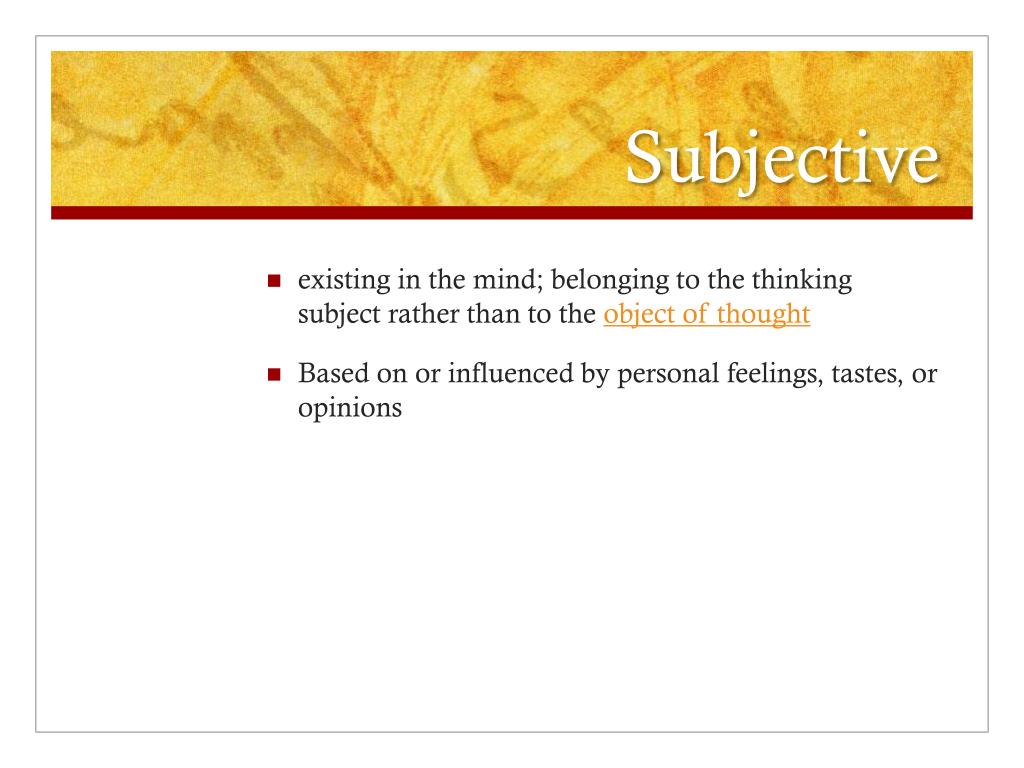
The initial idea came from Jan-Noël Thon's "Subjectivity Across Media: On Transmedial Strategies of Subjective Representation in Contemporary Feature Films, Graphic Novels, and Computer Games" (2014). The aim of this study is to lay groundwork for an analysis of markers of subjectivity in larp. The overall discussion compares medium-specific affordances of live-action role-playing, which are fairly limited in a player's gesture marking off-game status of the character, or movement from the main game area into a metaroom used for role-playing internal worlds.
Subjective perception definition code#
The paper adds one category to Thon's framework: symbolic markers, which are based on a pre-established code of arbitrary signs and are used to regulate the active agency or perception of the audience, e.g. For this and other reasons, larp has limitations in the use of simultaneous content markers and representational markers of subject-ivity, whereas contextual content markers and all narratorial markers present no difficulty. By contrast, representations of (quasi-)perceptual point of view and of imagined internal worlds are possible, although with some danger of unwanted metaleptic contact with another character's delusions. The first-person audience mode makes it hardly possible to switch to (quasi-)perceptual overlay, and to ever leave subjective spatial point of view, unless some of the prototypical principles of larp are broken. Unlike the audiovisual media discussed by Thon, in which it is intersub-jective perception that comes unmarked, larp by default is experienced from a subjective spatial point of view.


The fundamental difference lies in the 'first-person audience' (Sandberg 2004 Stenros & Montola 2010) mode of participation in larp. Thon's (2014, 2016) typology of forms of representation of character's subjective perception in film, graphic novels, and video games, and applies it to live-action role-playing. In its prototypical model, larp strives for a high degree of perceptual unity between player and character and prefers iconic representation via live action and live acting, with lesser importance of indexical and symbolic signification. Players combine the roles of authors, actors, characters, and audience.
Subjective perception definition full#
The emergent story is experienced by the full sen-sorium of the players' bodies and simultaneously uses the bodies as a medium of representation. It is approached as a narrative medium, used for performative and participatory co-creation of dynamic storyworlds. This work frames larp as a multimodal medium: based on live-action role-playing but also open for inclusions of other media and technologies. the use of narratorial markers in larp is very similar to their use in (audio)visual media), and reveals the larp-specific nature and/or larp-specific usage of other markers. The analysis confirms Thon's observations about the transmediality of some of the markers (e.g. The discussion is organised in three parts, corresponding with Thon's types of subjectivity: (quasi-)perceptual point of view, (quasi-)perceptual overlay, and internal worlds.

The hereby presented text focuses on markers of subjectivity, their three types (narratorial, content, and representational) defined by Thon and the fourth (metasymbolic) by myself.

This is a direct continuation of two previous papers, one positioning larp as a narrative medium in the context of transmedia narratology, the other researching storyworld representation / interpretation by larp participants. Thon's (2016) framework for analysing representations of character's subjective perception in film, video games and comic books, this paper studies representations of subjectivity in live-action role-playing.


 0 kommentar(er)
0 kommentar(er)
